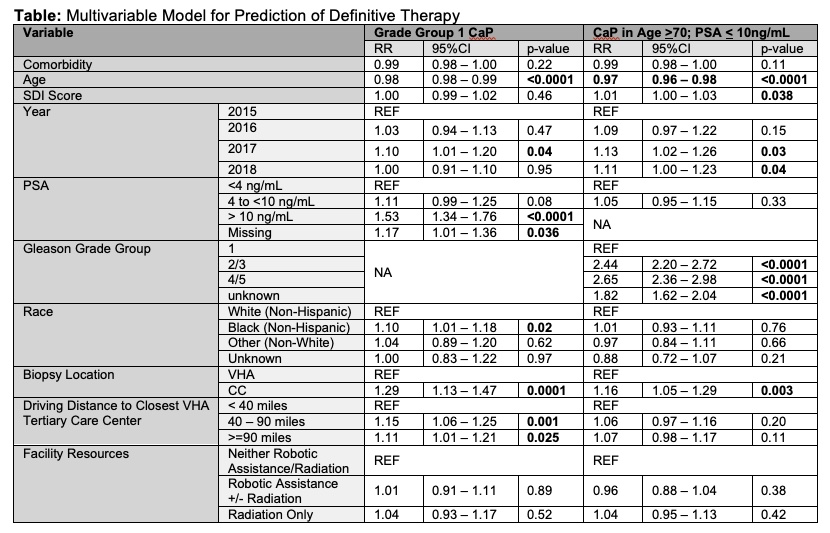Back
Introduction: The 2014 Veterans Choice (Choice) Legislation provided unprecedented access to non-Veterans Health Administration (VHA) healthcare facilities for men living > 40 miles from their closest VHA tertiary facility and/or men experiencing wait times for specialized care of > 60 days. The study purpose was to determine how non-VHA care supported by Choice affected receipt of definitive treatment (prostatectomy/radiation therapy) for low-risk prostate cancer (CaP) – a patient group for whom conservative treatment is strongly recommended by guidelines.
Methods: The cohort included 45,685 men diagnosed with CaP from 2015-2018 who regularly used the VHA. We used VHA claims data and the VA Program Integrity Tool to identify care provided inside and outside (Choice funded) of VHA facilities, respectively. The primary outcomes were 1) definitive CaP care for Grade Group 1 (GG1; Gleason 3+3 or less) CaP and 2) definitive care for men diagnosed at age >70 with PSA < 10 ng/mL. We used multivariable modeling to determine the relationships between patient, facility, tumor characteristics, and biopsy location with receipt of definitive care.
Results: We identified 10,499 (23%) men in the cohort with GG1 disease, of which 4097 (39%) underwent definitive treatment (Table). Definitive treatment among GG1 was predicted by lower age (RR 0.98), higher PSA (RR 1.53), Black (non-Hispanic) race (RR 1.1), distance from tertiary VHA (40-90 miles RR 1.15; > 90 miles RR 1.11) and non-VHA diagnostic biopsy location (RR 1.29). There were 6445 (14%) men with CaP that were older than 70 with PSA <10, of which 3836 (60%) underwent definitive treatment. Definitive treatment was predicted by higher Gleason Grade Group (2/3 RR 2.44; 4/5 RR 2.65), lower age (RR 0.97) and non-VHA diagnostic biopsy location (RR 1.16).
Conclusions: We found significant differences in managing low-risk CaP between Veterans receiving care in the VHA and those using their Choice eligibility to receive outside care. The location of the diagnostic biopsy appears to have the greatest impact on treatment and thus may represent a potential target of intervention to minimize the risk of overtreating Veterans with CaP by decreasing care fragmentation. SOURCE OF
Funding: U.S. Department of Veterans Affairs Office of Rural Health (OMAT 16010)

Moderated Poster Session
Session: MP48: Health Services Research: Practice Patterns, Quality of Life and Shared Decision Making II
MP48-12: Assessing the Impact of Veterans Health Administration Choice Legislation on Treatment of Low-Risk Prostate Cancer in Rural Veterans
Saturday, April 29, 2023
3:30 PM – 5:30 PM CST
Location: S505
- BE
Bradley Allan Erickson, MD, MS
Professor
University of Iowa
Poster Presenter(s)
Introduction: The 2014 Veterans Choice (Choice) Legislation provided unprecedented access to non-Veterans Health Administration (VHA) healthcare facilities for men living > 40 miles from their closest VHA tertiary facility and/or men experiencing wait times for specialized care of > 60 days. The study purpose was to determine how non-VHA care supported by Choice affected receipt of definitive treatment (prostatectomy/radiation therapy) for low-risk prostate cancer (CaP) – a patient group for whom conservative treatment is strongly recommended by guidelines.
Methods: The cohort included 45,685 men diagnosed with CaP from 2015-2018 who regularly used the VHA. We used VHA claims data and the VA Program Integrity Tool to identify care provided inside and outside (Choice funded) of VHA facilities, respectively. The primary outcomes were 1) definitive CaP care for Grade Group 1 (GG1; Gleason 3+3 or less) CaP and 2) definitive care for men diagnosed at age >70 with PSA < 10 ng/mL. We used multivariable modeling to determine the relationships between patient, facility, tumor characteristics, and biopsy location with receipt of definitive care.
Results: We identified 10,499 (23%) men in the cohort with GG1 disease, of which 4097 (39%) underwent definitive treatment (Table). Definitive treatment among GG1 was predicted by lower age (RR 0.98), higher PSA (RR 1.53), Black (non-Hispanic) race (RR 1.1), distance from tertiary VHA (40-90 miles RR 1.15; > 90 miles RR 1.11) and non-VHA diagnostic biopsy location (RR 1.29). There were 6445 (14%) men with CaP that were older than 70 with PSA <10, of which 3836 (60%) underwent definitive treatment. Definitive treatment was predicted by higher Gleason Grade Group (2/3 RR 2.44; 4/5 RR 2.65), lower age (RR 0.97) and non-VHA diagnostic biopsy location (RR 1.16).
Conclusions: We found significant differences in managing low-risk CaP between Veterans receiving care in the VHA and those using their Choice eligibility to receive outside care. The location of the diagnostic biopsy appears to have the greatest impact on treatment and thus may represent a potential target of intervention to minimize the risk of overtreating Veterans with CaP by decreasing care fragmentation. SOURCE OF
Funding: U.S. Department of Veterans Affairs Office of Rural Health (OMAT 16010)

